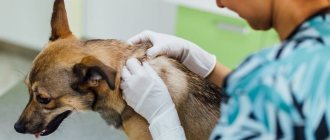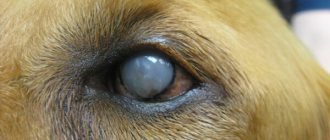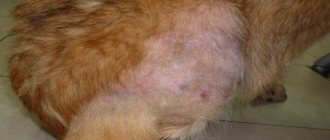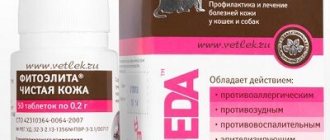- January 9, 2019
- Allergology
- Kira Ifeevskaya
In our article we will talk about how dog allergies manifest themselves. In addition, the reasons for this problem and ways to solve it will be considered. In the article we will also describe what hypoallergenic dog breeds there are. But first things first.
First, I would like to say that the occurrence of an allergy to dogs is a rather dangerous situation. As a rule, it occurs when a dog or puppy appears in the house.
Causes of allergies
Before describing how dog allergies manifest themselves, let’s consider the causes of this problem. Usually it is a congenital pathology. Although adults may also experience symptoms of allergies to dogs. Note that the signs of pathology are the same in people of different ages.
Sometimes allergies occur latently. If a person has short-term contact with a dog, he may not even feel a worsening of his condition at all. But with closer and constant communication, all unpleasant signs can appear almost immediately.
Next, we will look at the main factors that can further stimulate the occurrence of allergies:
- Poor environment and various irritants. They lead to malfunctions of the immune system.
- Diseases of an infectious and viral nature. Such pathologies weaken the immune system. As a result, the immune system begins to react incorrectly to familiar things.
- Hereditary factors. If parents have a predisposition to allergies, then there is a high probability that their children may develop such a problem. The percentage (up to 80%) of its development is especially high in a child whose both parents suffer from allergies.
Main symptoms of dog allergies
How to check if you are allergic to animals? The first thing you need to do is contact an allergist. This doctor can test you for allergens. This method is the most accurate. You can also pay attention to allergy symptoms. But the signs of all reactions are identical. Therefore, you will not be able to understand why exactly it arises for you. How does dog allergy manifest in adults? Main features:
- redness of the skin (hyperemia), signs of urticaria and dermatitis appear;
- cough;
- the nasal mucosa swells;
- rhinitis occurs;
- lacrimation;
- redness of the eyes.
Nasal congestion is also observed, breathing becomes difficult, and swelling forms in the throat.
You should pay attention to when the signs first appeared. If various symptoms of an allergy to a dog (cough, rhinitis, etc.) appeared immediately after interacting with your four-legged friend, then we can assume that you have this problem.
There are situations when it is not very easy to identify the source of the problem. For example, if symptoms of an allergy to dogs in an adult did not arise immediately, but some time after contact with the animal.
Usually, signs appear immediately after communicating with the dog. But there are also cases when allergies occur even when being in the same room with a dog. Of course, such situations make the process of determining the source of the allergy a little more difficult. Note that not all dogs can cause such a reaction, but only representatives of certain species.
If nasal congestion and other signs of allergies are associated with constant interaction with your pet, then you should give it away for a while. Then evaluate your condition, pay attention to whether there is improvement, when there is none.
If the allergy in the form of sneezing, watery eyes, coughing and hyperemia has gone away, then the problem is still in the dog. Of course, for a more accurate diagnosis you need to contact an allergist. The specialist will prescribe a series of tests, including a skin and blood sample for a radioallergosorbent test. Such examinations help to refute or confirm a person’s guesses about what causes his allergies. It also happens that such a reaction is provoked by moldy fungi, plant pollen, or street dust that people bring into the house.
Course of the disease in children
Sometimes, after an animal appears in the house where the child is, parents notice that the baby develops a rash, is capricious and refuses to eat. These symptoms indicate an allergic reaction.
Often, a dog hair allergy is actually a response from an immature immune system to allergic proteins present in the dog's body fluids, epithelial cells, and feces.
The amount of aggressive proteins depends on the size of the animal, its gender, living conditions and feeding. In addition, scientists say that animals with dark colors are much more likely to cause an allergic reaction in children.
In this case, the baby may experience skin hyperemia and burning, especially in places of contact with the animal. Infants begin to sneeze and cough frequently, and may experience wheezing and difficulty breathing. The mucous membranes become inflamed, and lacrimation is noted. In addition, an allergic reaction can provoke asthma in a child, which is quite difficult to neutralize. In severe cases, anaphylactic shock and Quincke's edema may develop. These conditions can develop instantly and pose a threat to the patient.
To identify a child's allergy directly to a dog, a blood test is recommended. It is extremely rare for children to be given a skin test, since due to the immaturity of the immune system, it can show questionable results. If the baby is breastfed, breast milk is analyzed for the presence of allergens.
As a rule, the most effective indicator is to stop contact with the animal. If, after fulfilling this condition, the negative symptoms gradually decrease, we can say with confidence whether there is an allergy to the animal.
Allergy treatment
We have already found out how allergies to dogs manifest themselves, now let’s talk about treatment. What to do in this case? Typically, therapy consists of relieving allergy symptoms. In such cases, a number of medications are prescribed to treat unpleasant symptoms that are caused by almost any allergen. These include:
- Drugs with a pronounced anti-edematous effect (for example, Sudafed and others like that).
- Dog allergy tablets that block the action of the allergen. Similar drugs include Claritin, Suprastin, Erius and others.
- Corticosteroids. These products are produced in the form of aerosols for intranasal use.
- Vasoconstrictors. The products are used at the first signs of allergies in order to eliminate swelling of the nasal passages.
Cleanliness is the key to success
We've already figured out how an allergy to a dog manifests itself. Now let's talk about how to deal with it.
Castration or sterilization of an animal significantly reduces the amount of allergen in the room, which is intensively produced in dogs during periods of hormone release. It is also necessary to monitor the cleanliness of the coat, because this is where aggressive proteins accumulate. To do this, the animal should be bathed at least once a week with special shampoos and its fur should be combed every day. All pet care operations should be carried out by a person who does not have allergic reactions.
Particular attention should be paid to the cleanliness of the room: regularly carry out wet cleaning and prevent the appearance of places where dog hair accumulates in the apartment. To reduce the level of allergens, you should hang tulle on the windows, get rid of carpets, store bedding in closed areas and use an air purifier. It is imperative to prevent stagnation of air in the room, take care of personal hygiene after contact with the animal, and do not allow it to be in the bedroom.
Complementary therapy
Sometimes specialists prescribe a course of injections. But, unfortunately, they are not always effective and capable of coping with such symptoms. Also, to improve the condition of the immune system, people are prescribed immunostimulants. This group of drugs includes drugs such as “Immunal”, “Timogen”, “Imudon” and others.
Experts advise not to ignore any allergic manifestations, since if treatment is not carried out, the acute form will become chronic. Then the person will constantly experience all the signs that interfere with normal life: sneezing, coughing, etc.
If you have been diagnosed with a disease such as bronchial asthma, then know: experts say that most patients with this diagnosis show signs of allergies to animals. Close contact with a pet can lead to an exacerbation of the disease and dangerous consequences, such as suffocation.
Allergies in children
We have already found out how dog allergies manifest themselves in adults. How are things going with the children? What are the symptoms of allergies? Most often, the child’s body reacts to animal fur. Sometimes 15 minutes of playing with a dog is enough for the baby to show primary signs of illness. Children under five years of age are usually most susceptible to this reaction. Let us note that if the allergen is wool, then the provocateur of the disease can be not only its owner, but also things made from it.
How does dog allergy manifest in children? The standard symptoms in a child are slightly different from those in an adult. It includes such signs as:
- swelling of the mucous membranes;
- breathing problems;
- rash and redness on the skin;
- frequent sneezing.
Heredity
However, not all people experience allergic reactions to dogs to the same extent. Some human organisms do not react at all to four-legged friends, while others experience discomfort with varying degrees of success.
How does a dog allergy manifest? The most unlucky people have to deal with severe symptoms. Why does such selectivity occur? First of all, heredity plays a big role. Provided that one of the child’s parents has an allergy, the probability of passing it on is 50%. If both adults suffer from the disease, this figure rises to 70%. However, the type of allergy does not affect tolerance. For example, the mother may have a stuffy nose during the flowering season, and the father may have an allergic reaction to certain foods.
How long does it take for a dog allergy to appear? She doesn't keep you waiting. Like any allergy, it makes itself felt immediately. The main thing is not to confuse it with some other allergic reaction.
Allergies to dogs in infants and children who live with dogs
I would like to note that the situation when treatment is prescribed for constant contact with an allergen, that is, an animal, deserves serious attention. However, in practice, one interesting trend has been noticed: small patients who live in the same apartment with a dog, more often than adults, get used to the stimulus. After which the negative reaction completely disappears.
I would also like to say that infants need special attention. Since they often notice symptoms of allergies to wool. The most common symptom in infants is atopic dermatitis. The skin on the face is usually affected. But as the disease progresses, the rash appears on other parts of the body. In addition, allergies in infants are often accompanied by swelling of the mucous membrane and larynx.
If a child is allergic to a dog, what to do? Of course, go to a therapist who will examine the baby and find out whether he really has a reaction. Next, the doctor will send you to an allergist, who will prescribe several tests; based on their results, the diagnosis will be known for sure. After which the doctor will be able to select the appropriate treatment.
How to determine allergies to cats and dogs
There are a number of characteristic signs that indicate an undesirable reaction of the body to animal fur. This is the appearance of symptoms, which are usually attributed to allergies to fur or urine, saliva, feces of pets (the signs are listed above in the text).
If you are prone to such manifestations, you should take timely measures to stabilize the condition and prevent recurrent attacks.
Choosing a hypoallergenic pet
A lot of research has been conducted into the existence of hypoallergenic breeds. First of all, their feature is associated with less shedding. During this process, the allergen spreads abundantly. In addition, dogs whose salivary fluid has a low protein content are less likely to cause various reactions. Also, so-called slobbery breeds are not at all suitable for allergy sufferers.
I would like to say that sometimes it happens that hypoallergenic dogs still cause similar reactions in people. In addition, there have been cases in medicine where two animals of the same breed had different effects on health. That is, one individual provoked an exacerbation, while the other did not cause any similar reactions.
So how can you find out whether your future pet will provoke an exacerbation of the disease? Not until the animal comes to your home as a new family member. Take it first, for example, for a while. If it does not have any negative effect on the human body, then you can already think about keeping the pet.
It is advisable to negotiate such a possibility with the breeder in advance. When choosing a hypoallergenic dog, there are some things to consider:
- You should not take dogs that bark frequently. It is believed that when a dog barks profusely, it produces a lot of saliva, which contains the allergen.
- Preference should be given to dogs that shed less. There is also an opinion that representatives of long-haired breeds cause the strongest allergic reaction. However, this statement is incorrect. The risks of exacerbation of the disease are higher if a dog with short hair lives in the house and sheds all year round. In addition, cleaning such hairs is quite a difficult and sometimes even impossible task. If an allergy sufferer lives in the house, then it is better to take a small dog, since fewer hairs will separate from it than from a large one.
Hypoallergenic dog breeds
What dog breeds are you not allergic to? To hypoallergenic. Scientists have conducted studies that have revealed the ideal breeds for people with allergies. We will get acquainted with them later in the article.
These breeds include:
- Yorkshire Terrier. This is a small dog with long fur and no undercoat.
- Bichon Frize. The breed comes from France and belongs to the group of lapdogs. The Bichon Frize is a small dog that does not shed and does not require daily grooming.
- Poodle. Decorative breed of dogs. These dogs practically do not shed. There are several types of poodles of different sizes (toy, large, toy and small).
- Maltese. This is a variety of Bichon with luxurious, long hair.
- Irish Soft Coated Wheaten Terrier. Another hypoallergenic breed. Its representatives are dogs with silky soft hair without undercoat.
- Chinese Crested. These are hairless dogs that have hair only on their limbs, head and tip of the tail. There is such a variety of crested as downy. She is completely covered with fur, but has no undercoat.
- The Xoloitzcuintle is a Mexican hairless dog. Representatives of this breed do not have hair. Although there may be puppies in the litter with its presence. Representatives rarely cause allergies in people, and they are odorless.
- Schnauzers. This is a whole group of breeds, which includes Giant Schnauzers, Miniature Schnauzers and Miniature Schnauzers. A distinctive feature of these dogs is their hard coat with a dense undercoat. Representatives of the breed do not require regular trimming or plucking. Because their hair falls out on their own.
- Bolognese. This small dog breed comes from Italy. Like all similar species, representatives of this breed are not subject to shedding. Such dogs only need to be brushed daily, but they can be cut at will.
- Bouvier des Flanders. These are large herding dogs with a hard, dense coat. They also have a thick undercoat. Requires regular trimming.
- Bedlington Terrier. Representatives of the breed are distinguished by their brave disposition, look like sheep, and practically do not shed. They need a haircut 3-4 times a year.
- American Hairless Terrier. Representatives of the breed are completely hairless, but require special skin care. In addition, during the cold season they need special clothing.
- Dwarf Spitz. There are several varieties of the breed, namely: German, Pomeranian, bear type. Representatives of this breed are distinguished by their fluffy fur and pretty appearance.
- Welsh Terrier (Welsh Terrier). This is a non-shedding, coarse-coated dog that is not difficult to care for.
- Affenpinscher. This is an ancient hypoallergenic breed that belongs to the miniature pinschers.
How to cure dog allergies using traditional medicine
Traditional medicine also has recipes that help reduce allergic symptoms. For example, decoctions of St. John's wort, rose hips, viburnum or chokeberry will be useful if taken half a glass once a day.
If the body’s reaction is very strong, then mummy, which must be dissolved in licorice decoction, will help. Licorice is infused for 1 hour and in 500 ml. 0.5 grams of mumiyo are added. Drink the decoction in the morning on an empty stomach, 200 g once a day. Prepare a portion for 2 servings. After 2 days you need to brew a new decoction.
A decoction of nettle flowers will also help. You need to brew 1 tablespoon of flowers in 250 g. boiling water Leave for 30 minutes. Drink half a glass 3-4 times a day. The decoction should be slightly warmed before use. A decoction of dead nettle (nettle) helps if you have acne, hives, eczema and other rashes on your skin.











